Analysing Manchester United’s Stuttering Start
Manchester United have suffered a turbulent start to the 2020-21 season, despite surprising victories against PSG & RB Leipzig that leave them on the verge of qualification from a challenging Champions League group, Ole’s team have stumbled against too many an opposition.
With humbling defeats against Tottenham and Istanbul Basaksehir and struggles against teams in direct competition such as Arsenal and Chelsea, the Red Devils are at a potential pivot in their domestic season with improvement required if they are to get back on track to reach their minimum aim of a top four finish or even competing higher up the league table. This piece will look to scrutinize the strengths and weaknesses of United’s current tactical approaches and uncover insights into areas of improvement to put them back on a positive trajectory.
Build Up & Attacking Movement
It is evident from their matches so far that United prefer a 4-2-3-1 system, with limited exceptions to the rule displayed during the suspension of Anthony Martial or when fitting in a highly congested midfield contingent. It is from this standpoint that they have displayed their most promising aspects of performance, with varying strategies employed to take advantage of the advancement of attacking full-backs, consequently enabling an assortment of attacking schemes in wide areas. Within deeper build-up, this is fundamentally enabled through one of the double-pivot midfield dropping into differing spaces between the back four to create a temporary back three, allowing the full-backs to push much higher.
The two strategies employed to generate this are portrayed below. The first with Matic dropping 10 yards deeper to occupy a central centre-back position whilst Pogba maintains secure possession, consequently pushing Lindelof and Maguire into half-back positions within the half-space. As a result, with more defensive security Shaw & Wan-Bissaka can move higher into the widest lanes to occupy a position beyond the opposition’s midfield line (integral so that they can receive and break lines & to be explored later on), completing a smooth transition from a back four to a temporary back three. The second is similar in the actions it triggers, whilst there are slight differences to individual positioning changes. Whilst Lindelof has possession, Fred drops into the space between Maguire and Shaw, becoming a half-back in effect once again creating the momentary back three. The differences lie within both Maguire and Lindelof then being shifted to the right and Maguire occupies the central lane as centre-back, with Lindelof pushed out to half-back in the right half-space, Wan-Bissaka & Shaw can then utilise this as a trigger to push beyond the opposition’s midfield line to receive as there is sufficient defensive security.
The initial benefits are clear within that United’s back five now reside within different vertical/horizontal lanes to help circulate possession to break past the opposition’s strikers with full-backs in advanced positions to support play when they do (if they occupied less lanes it provides less width/depth thus condenses the space for vertical penetration between opposing players), whilst the central back three are in a position to shift the ball between themselves with a natural increase in passing angles into midfield (as opposed to two “square” CB’s, United now have two half-backs with greater opportunities to play diagonal passes into central or wide areas due to increased width/depth between them). Although, individual personnel strongly influence these approaches, Matic is the most comfortable and frequently drops in when chosen, though Fred is less likely to even though he has demonstrated the willingness to do so. In contrast, McTominay rarely drops in to create this back three, hampering the variety of United’s build-up play and often opting to stay between the centre-back pairing when employed as the deeper of the double-pivot (creating a point-up triangle).
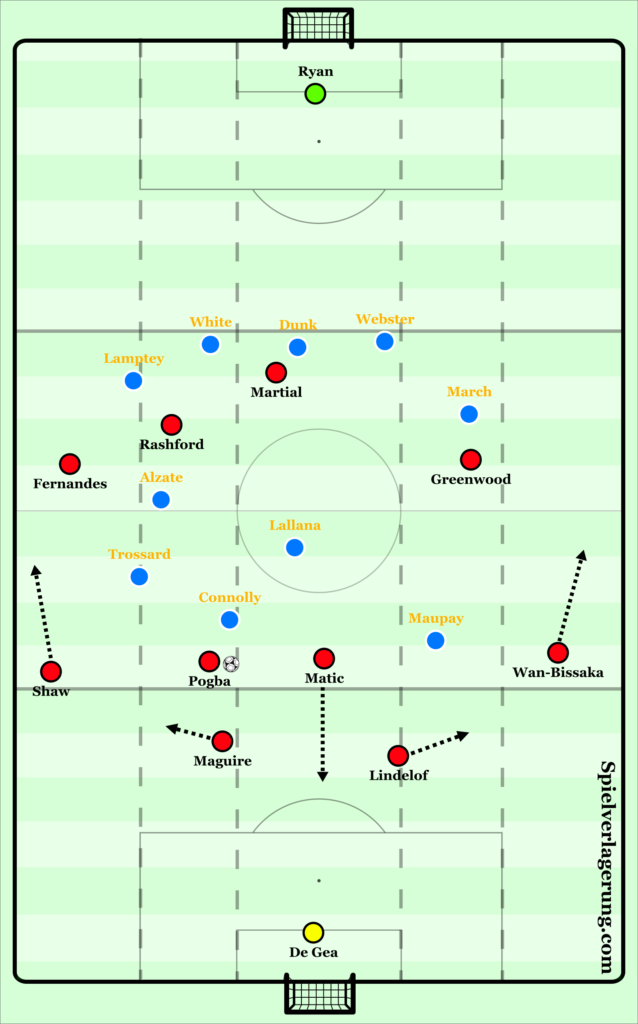
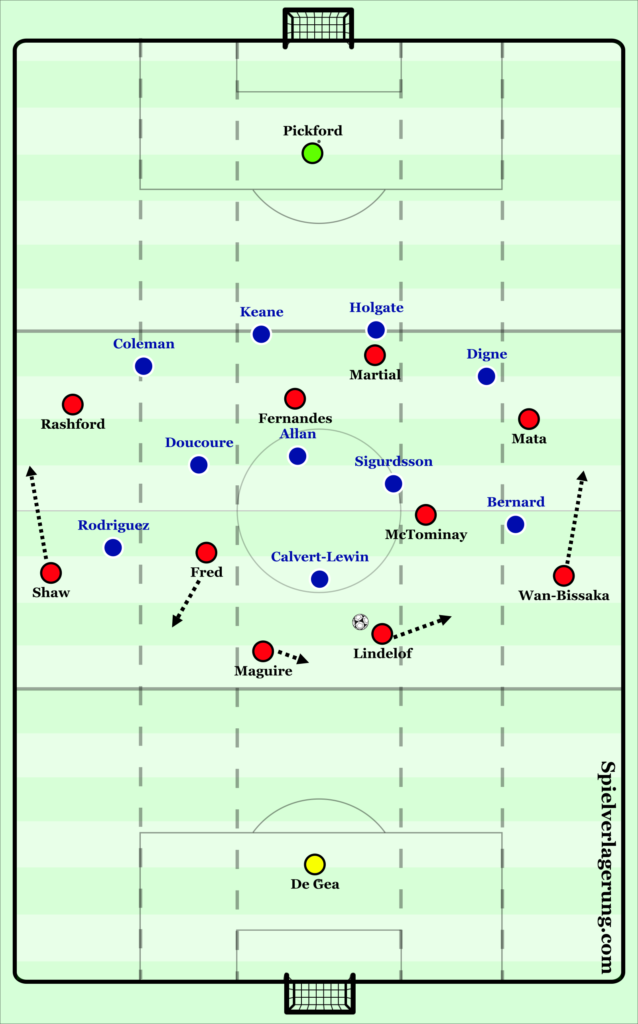
The standalone aim of this systematic manipulation is to enable the shifting of possession or sufficient defensive security between the back three to allow one of them to step in and break past the opposition’s first line, creating an opportunity to disrupt and attempt to penetrate the opposition’s midfield line with specific focus upon half-spaces and wide lanes (particularly relevant when attempting to create overloads in midfield areas against compact teams). This is displayed against such a team in West Brom below who played a 5-4-1 (box midfield out of possession), with Lindelof stepping in to create the overload with the intention of disrupting West Brom’s structured midfield box in order to penetrate beyond it upon the trigger of Matic taking up the deeper central centre-back position.
The impact of this is to initially draw Diangana out of the structured midfield box, whilst it also takes the attention of Gallagher, allowing Mata and Martial to move into potential receiving positions beyond his forward facing perception. As a consequence, this allows Mata the opportunity to combine in a number of ways with 3rd man runs from both Wan-Bissaka and Fred that could have penetrated West Brom’s last and midfield line respectively. Whilst this is exemplified against a lone striker, the principles remain against a front two with simply a little more patience required from the back three to play between themselves to find the one man overload whom can then step forward to progress.
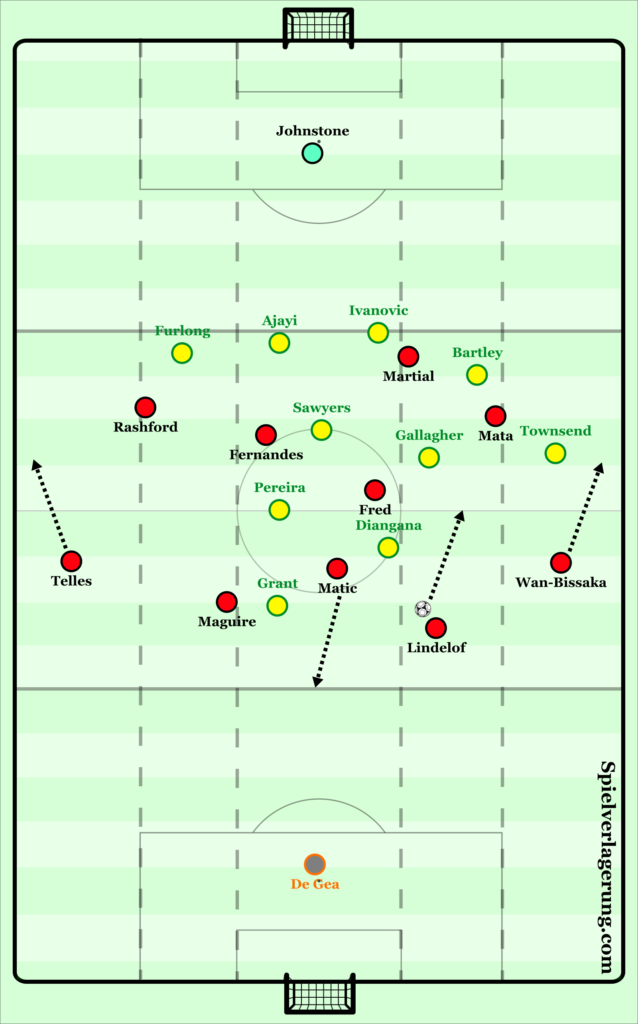
Once play has progressed past the opposition’s attacking line, the aforementioned heightened position of full-backs provokes one of United’s most prevalent strategies, creating wide 2v1s against opposition wingers (and subsequently full-backs). This is particularly effective against opposition back four’s as displayed against Tottenham below by isolating the opposition wide players, allowing the penetration of the midfield line in the first instance with following combinations opening the opportunity to break the defensive line as well. With the advancement of Shaw beyond the opposition’s midfield line, whilst it also works if he is in front of it with a little more required combination between himself and Rashford, it allows Rashford to utilise this as a trigger to push into a narrower position within the half-space creating a 2v1 against Lamela with the detail of retaining a position to receive both between the Spurs’ near-side central midfield and winger as well as behind them, breaking lines with one pass (whilst also allowing him to receive with an open body orientation to play passes forward immediately).
Upon Matic receiving, due to the highlighted positioning of Shaw/Rashford he has two opportunities to break the opposition’s midfield line, with the ball played into the narrower Rashford in the scenario below. Therefore, upon Rashford receiving and penetrating the midfield line in the process, Shaw can make a 3rd man run beyond Aurier to play beyond the last line in wide areas and provide an opportunity to cross/cut-back. Rashford’s position is integral in the way he receives, with his body orientation already facing Shaw to enable a front foot pass around the corner should Aurier choose to engage (he doesn’t in this instance in order to retain central compactness). Likewise, this picture is replicated on the right hand side with Wan-Bissaka and the ever changing right-winger in United’s line-ups.
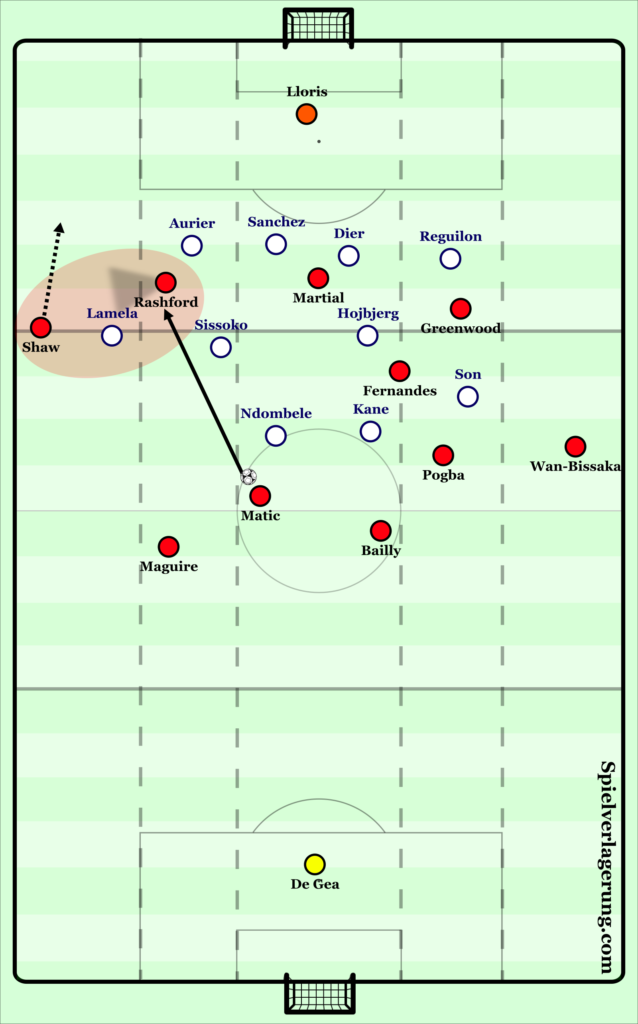
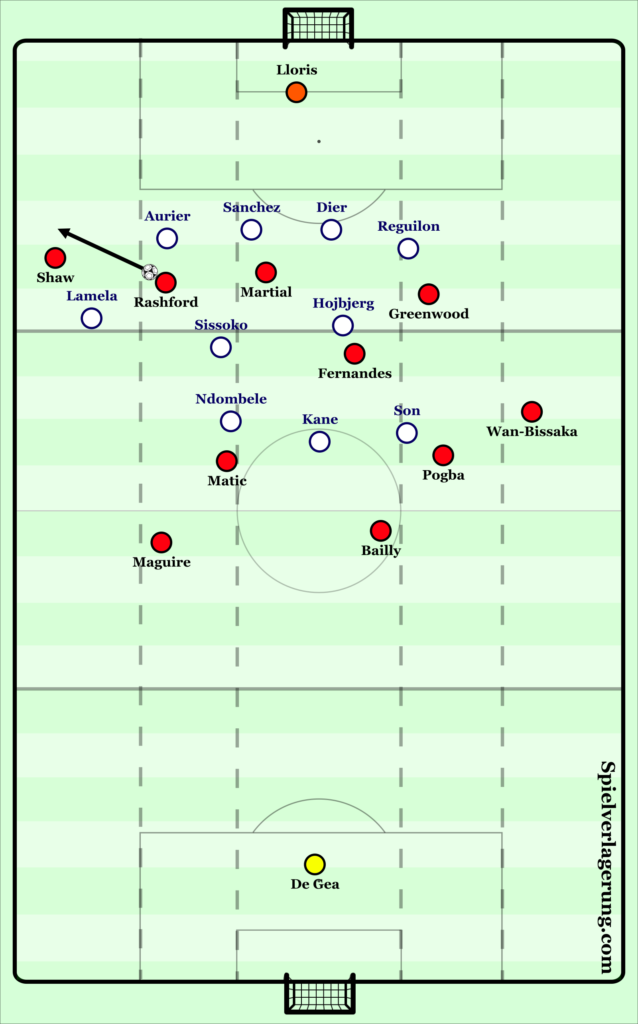
United also have an intriguing inverted rotation based upon receiving in deeper areas and travelling into vacated space to break lines, in the event that the opposition adapt their strategy to either have the full-back marking “in contact” (reducing the ability to combine) or having the wide player drop deeper to prevent the 2v1 and thus combination to penetrate. This worked especially effectively against Everton, mainly due to Coleman’s lack of commitment to stepping in to be “in contact” and rather preferring to stand off, leaving Rodriguez to mark Shaw and leave Rashford free in a deeper area.
As portrayed below, upon the pass into the near-side centre back as a trigger, Shaw vacates his tucked-in position (he often takes up this position when possession is on the opposite side) to push into an unusually high/narrow position for a full-back, whilst Rashford drops deeper onto an opposite line to receive possession in the widest lane on the front foot allowing him to drive inside. Following this, upon Rashford receiving, Shaw makes a move out wide which draws Rodriguez away from a central area and ensures Rashford can drive inside to the space between Rodriguez/Allan, breaking the opposition midfield line with both the ability to combine with Martial/Fernandes or play into Shaw in wide areas who has the ability to cross (if in the final third, Rashford will often use this as an opportunity to drive inside and shoot).
This movement to drag inside players away also occurs should Shaw receive as the deeper player, with Rashford moving out wide to create a passing lane to Fernandes/Martial should he not look to combine. Additionally, if Coleman/Rodriguez do follow Shaw/Rashford respectively in a more aggressive approach, it provides the opportunity for more direct play in beyond the opponents defensive blocks with penetrative runs into the half-space available from either Fernandes or Martial. This scenario enables United to counter-act opponents who may sit in deeper blocks as a back four and present the scenario to open them up in an alternative strategy (albeit one that is lob-sided with this happening infrequently on the right hand-side).
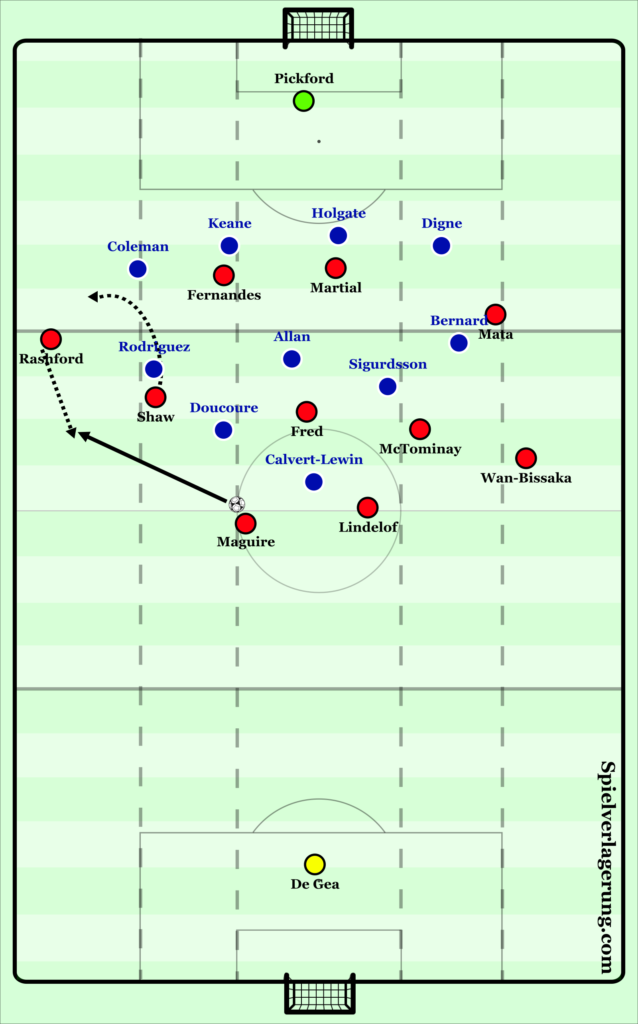
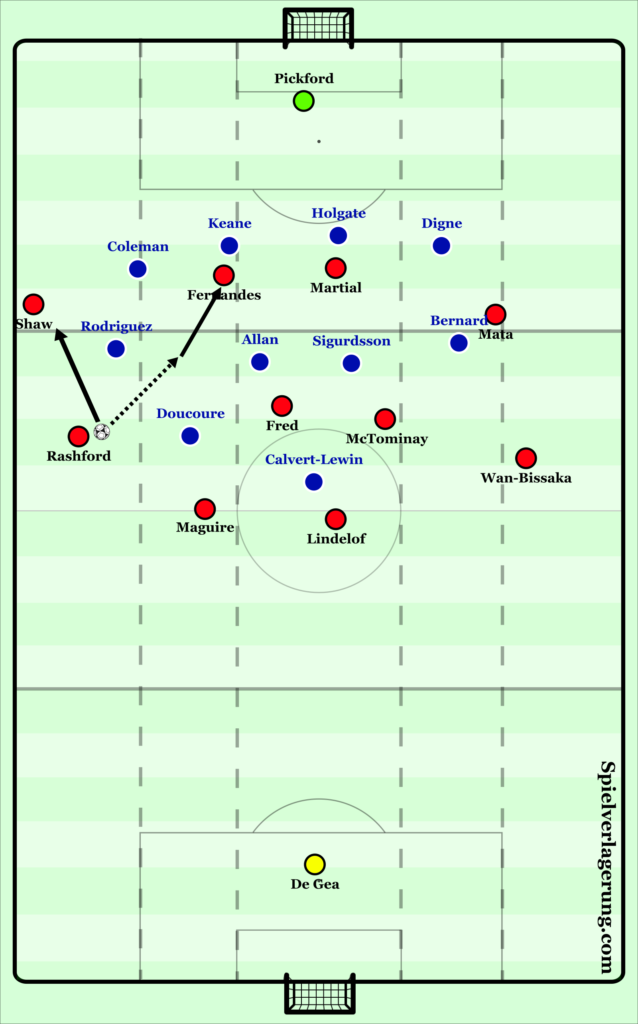
However, the extent to which either of the above manipulations are successful is severely diminished if an opposition is employing a back five (even less successful if within a low block structure), with the sufficient cover in half-spaces as demonstrated in the graphic below and is a scenario where United have found themselves to be much less effective. As shown, the 2v1 is no longer a possibility with Ajayi (right half-back) able to cover and travel upon any pass into Rashford to force play backwards, whilst Furlong has the ability to man-mark Telles when possession reaches the final third (even with rotation, the scenario remains the same).
This is without the consideration that Sawyers can also press Rashford from a near-side midfield position as one of the deeper players within West Brom’s midfield box. It must also be highlighted, that the low block nature of West Brom’s approach also stifled United’s penetrative ability, as with shorter vertical distances between defensive and midfield units combined with the immediate pressure from behind through the half-back’s upon Rashford limited the ability to combine freely or receive with an open body orientation to play forward passes. Further to this, the flexible midfield box also prevented central penetration with the ability to combine a screening front-two (Diangana/Pereira) with a deeper lying duo (Sawyers/Gallagher) to initially restrict and secondarily maintain pressure upon passes into central areas, limiting Bruno Fernandes’ influence in the process.
As a consequence, United were regularly limited to recycling possession horizontally in an attempt to open up gaps between West Brom’s highly organised and compact approach, one which they struggled with and only exacerbated the lack of deeper creativity (Matic/Fred) within their line-up, perhaps an insight for United’s future opposition to pick up on or to strengthen the argument for the deployment of Van de Beek/Pogba within the double-pivot. The only saving grace is the positive impact of Bruno Fernandes free-role in these circumstances (to be explored in a standalone section later on).
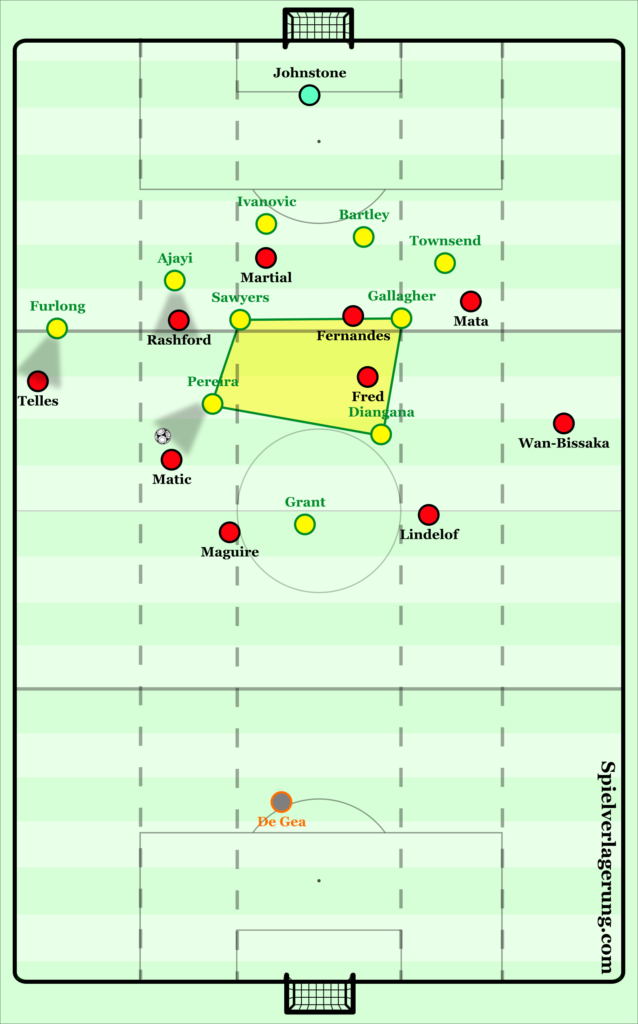
The final positive aspect to consider of United’s attacking play (with the exception of Bruno Fernandes standalone latter section), is the fluidity and freedom provided to the attacking unit within their attacking exploits. Especially when playing against structured opposition, it presents the opportunity to disrupt opposition structures through both horizontal (e.g. Mata & Martial) and vertical rotation (e.g. Fernandes & Martial) with dual outcomes. The first outcome of manipulating the opposition and creating space through rotations is to exploit space should opposition follow players’ movements, creating opportunities for deeper players to penetrate with forward passes to break lines. Furthermore as a second potential outcome, it also allows for players to break lines should they find themselves in a position to receive behind opposition players whilst in transition, often if players have not been following during rotation.
The vast majority of these rotations are position structured as opposed to complete freedom of movement, with players simply adopting positions that players had previously occupied, ensuring that United’s general play stays consistent within pre-determined patterns of play (such as the wide 2v1s and wide rotations displayed previously). Although, Mata does seem to have the most flexibility (outside of Fernandes – to be revisited) with Martial and Rashford performing more “rehearsed” movements. However, the limitation of this is that the opposition can pre-empt these position-specific rotations and prepare for them as they are predictable to an extent, though in match-play with the various psychological stresses (concentration/awareness) this becomes a much more difficult proposition.
These rotations are often based upon triggers of backwards passes or shifting possession between central-defenders, both implying that there is a lack of receiving players and that movement is required to create available passing lanes. The below depiction translates these conceptually (against West Brom’s low block 5-4-1) and how they positively influence attacking play, utilising the rotation to exploit receiving in half-spaces during rotation and progress through wide areas with the combination of 3rd man runs from attacking full-backs.
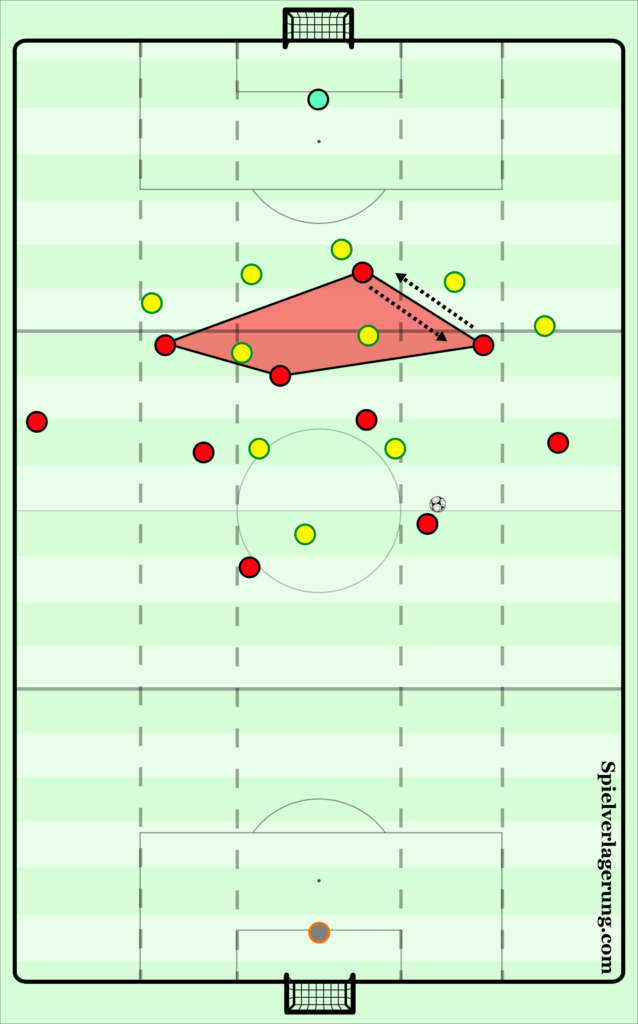
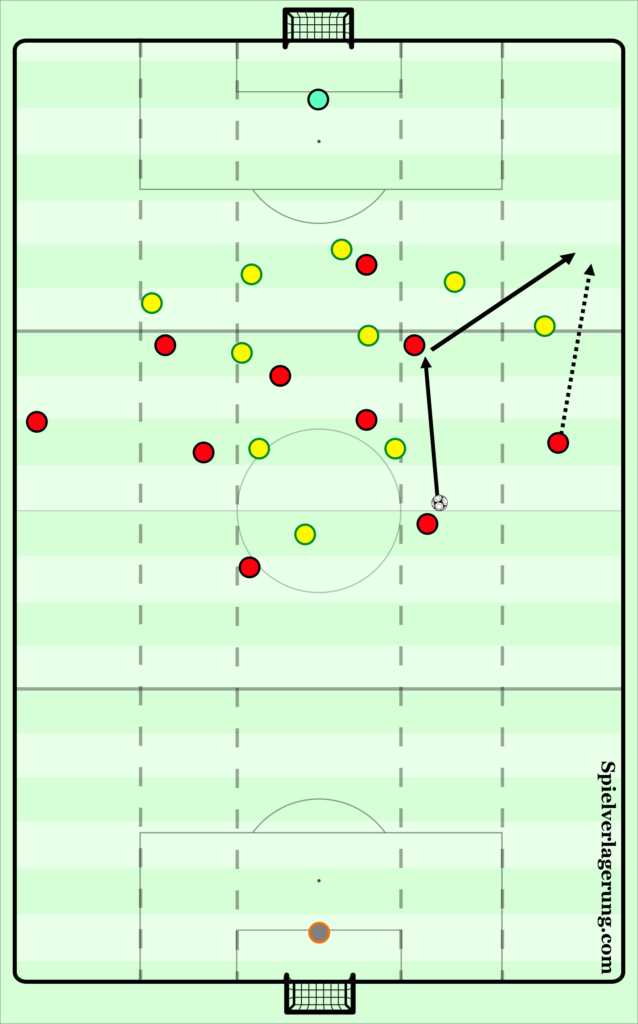
However, there have been challenges within United’s approach to in possession play, fundamentally orientated around a lack of technical quality in key areas. The first of these can be portrayed within their ability to play out. Against the majority of opposition, whom are often inferior both domestically and across European competitions, United rarely face high pressing approaches with their opponents opting rather to sit into deeper low/medium blocks. This allows United to play out efficiently, utilising the previously displayed “temporary back three” (at times even this isn’t required against excessively defensive teams with only a lone pressor) to create necessary overloads and circulate possession until the opportunity arises to step forwards to break the opposition’s attacking line.
However, when facing up against those of a similar stature and opposition who are willing to be aggressive in restricting United’s ability to play out from the defensive third, it has caused strain and displayed a weakness that needs to be rectified somehow in Ole’s approach. The representation of Arsenal’s pressing approach exemplifies this directly. As illustrated below, Arsenal’s 3-4-2-1 transitioned into a 3-4-1-2 when pressing high (Lacazette flipped from a point-up to a point-down in effect) with their strategic aim to force United into a congested central area forcing them to combine in tight areas under extreme pressure and force a mistake from which to regain possession, perhaps due to the fact that United would prefer to filter play down their stronger wide areas. Upon a pass into Lindelof by De Gea, Aubameyang refrained from engaging rather front-screening a pass into McTominay, whilst Willian restricted the ability to pass into both Maguire/Shaw, Lacazette in his deeper position stayed man-man against Fred.
Beyond this first line, Saka/Elneny/Partey occupied a man-man approach on Wan-Bissaka/Fernandes/Pogba respectively, preventing the opportunities for a direct pass into the second line whilst Rashford and Greenwood were covered by Arsenal’s remaining back three. As a result, Lindelof’s only decision was to either bounce back to De Gea or to step into the midfield unit which as has been frequently displayed by United was the natural course of action. However, upon the trigger of stepping into midfield, Willian pressed from behind upon Lindelof causing immediate pressure to release the ball and with the remaining options in midfield under a man-man orientation and last line passes covered by Arsenal’s back three, Lindelof was forced to play into a pressured Fernandes (Pogba was passed on from Partey to Aubameyang as he moved across Lindelof’s path). This ultimately led to a failure for Fernandes to combine with Wan-Bissaka, an interception by Saka leading to a counter-attack from Arsenal (a theme that was consistent throughout the match).
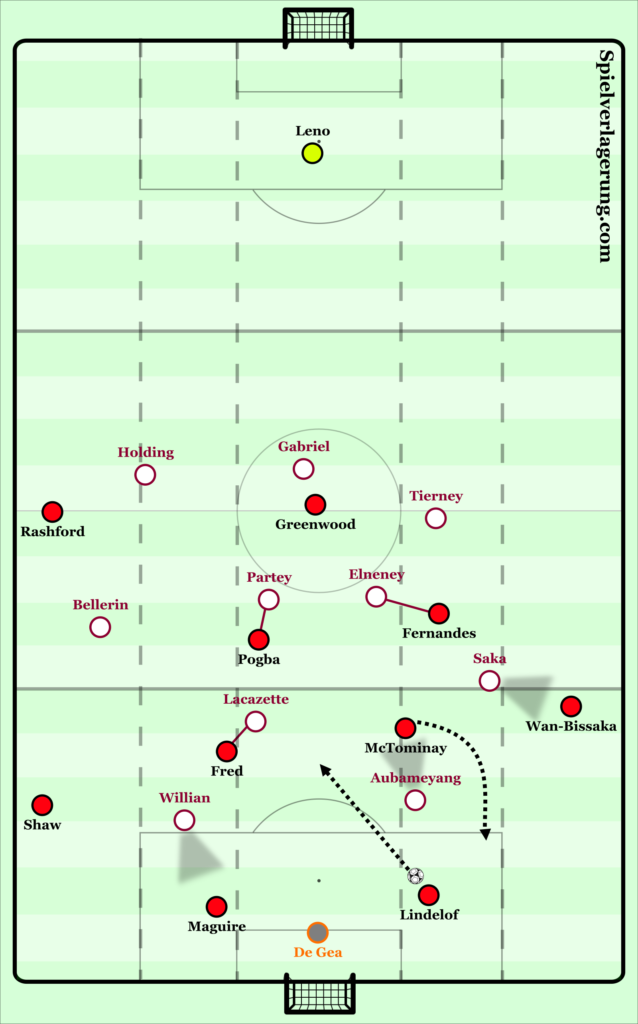
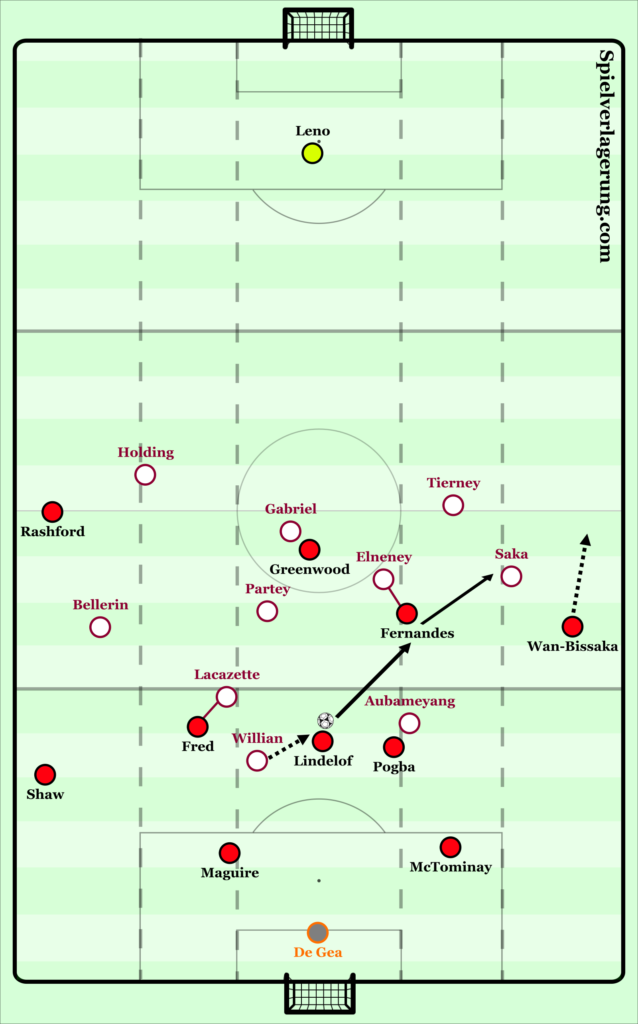
This provokes thought for the underpinning of the issue presented, on face value it seems that Lindelof’s failure to step in and Fernandes inability to receive under pressure caused the mistake. However, as much as this did contribute, this is unfair as Lindelof cannot be expected to suddenly become a midfield player to produce incisive passes when he is used to playing with the game ahead of him, whilst Fernandes has already displayed his prowess numerous times, the issue lies deeper within what did not occur. The fact that Arsenal were able to cut off United’s double-pivot from receiving, restricting the ability to even bounce possession out wide to full-backs which would have broken Arsenal’s central focused press is the main issue.
This double-pivot or at least one of them (ironically as Partey/Elneny displayed frequently during the match) should be able to receive under pressure, receive beyond opposition players when required and utilise individual movement/team rotations to break out of presses against the highest calibre of opposition, any of which would have broken the press, yet they are seemingly unable to do so. This aspect is only compounded further when contemplating United’s penetrative ability in higher areas of the pitch, with a similar theme evident. When needing to unlock deeper lying defences, United have lacked the creativity from deeper areas to either slot passes beyond the opposition’s midfield line with sufficient weight/accuracy to break lines or clip possession into limited space beyond the opposition’s last line to forward runs from Rashford/Fernandes/Martial which would in turn create space between the opposition’s defensive and midfield line for ensuing attacks. The simple conclusion is that McTominay/Fred/Matic are unable to be the deeper pairing that United need to develop a creative edge in these scenarios, a balance is required and whether United have those replacements available through Pogba/Van de Beek who can combine with McTominay/Fred/Matic is still to be seen.
Bruno Fernandes’ Free Role
Bruno Fernandes’ is no doubt the most pivotal aspect of United’s attacking exploits, therefore it is appropriate to assess the magnitude of his impact within a standalone section. The stark contrast to other players within United’s squad is his complete positional freedom, with this section examining how the freedom that he is allowed positively impacts United’s offensive potency. The first consideration is his receiving position within the 10 role, of which he spends the majority of his time, with a specific focus upon how he enables the penetration of the opposition’s midfield line. Fernandes maintains a higher position beyond the back shoulder and on the blind-side of the opposition midfield as much as possible, in order to break lines upon successful passes into him (whilst it also presents the opportunity to combine with players further ahead of the ball quicker). Furthermore, the freedom afforded to him to roam not only in the central lane (as a more rigid 10 would do) but also into the half-spaces and even at times into the widest lanes through rotations makes his play unpredictable.
As a result, it prevents opposition midfielders tracking him as he drifts between them from a blind-side position and never stays in the same area for prolonged periods of time, meaning front-screening him becomes ineffective unless the opposition’s midfield are exceptional within both their awareness and communication to nullify him (and as of yet, no one has tried to force a man-marking approach to restrict his influence). Taking the level of detail further, is to consider his positioning to create diagonal passing lanes, displayed through the below depiction in the return group game at home against Istanbul Basaksehir’s out of possession 4-5-1. As shown below, with possession in the left half-space Fernandes positions himself on a diagonal passing line in order to receive between opposition midfielders and break lines (in this instance it was in the central lane, but against less compact opposition could easily be further across in the right half-space).
If possession is transferred to the right, Fernandes drifts onto the opposite side of the pitch to receive on a diagonal line once again in either the central lane or left half-space to penetrate the opposition’s midfield line (if possession is central, Fernandes will position in either half-space to create this diagonal passing line). The benefit of this is that as opposed to receiving on a straight line, it allows Fernandes to receive directly onto his back foot with heightened awareness of players positioning ahead of him and thus combine with players ahead of him quicker, whilst it also provides natural disguise on the pass and discourages the pressing trigger that a straight line pass with a closed body position (and limited perception) would invite.
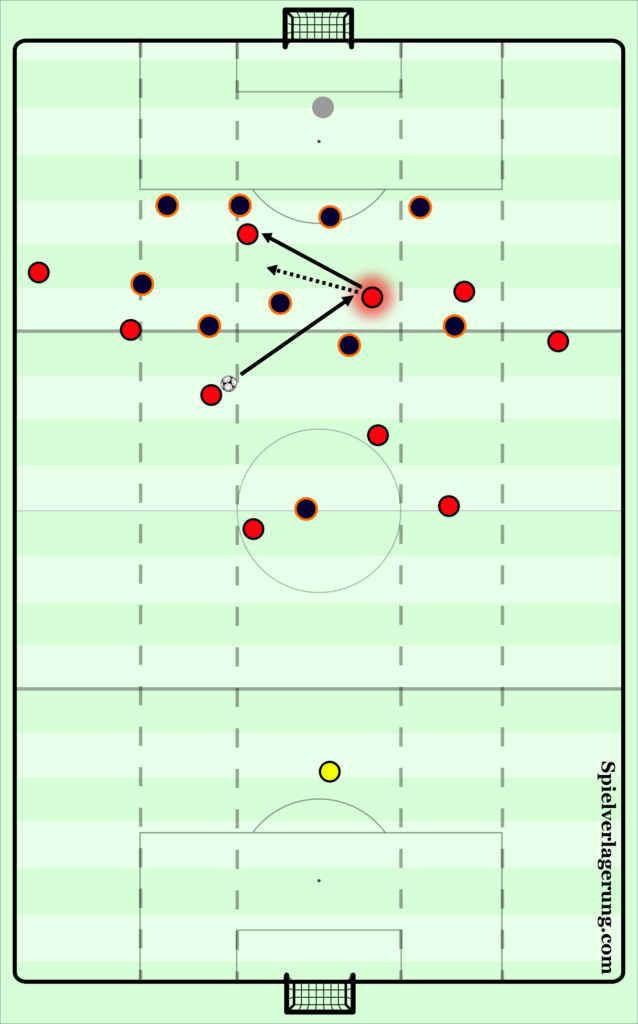
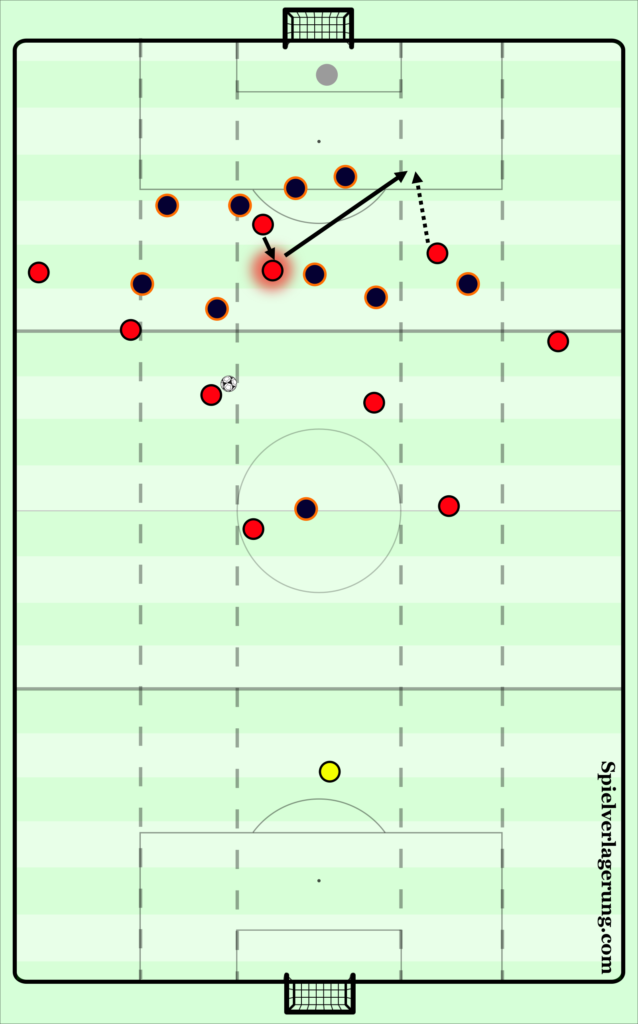
However, the premise of Fernandes’ receiving beyond the opposition’s midfield line is based upon having the sufficient quality in deeper areas to reach him, and as seen when pairing a duo of Matic/McTominay/Fred United have often lacked the quality to slot the ball into these congested areas with success (conveniently, the pass in the above scenario was played by van de Beek). Consequently, Fernandes has an alternate freedom to drop into deeper areas and receive the ball, becoming the deeper creative individual that United require and allowing himself more impetus to influence the game.
This is overwhelmingly displayed in wide areas, with central space occupied by the deeper lying double-pivot whilst wide areas (in front of the opposition’s wide players) are often vacant due to the high positioning of United’s attacking full-backs. If full-backs dropped deeper and occupied the space for Fernandes to receive, then this would provide the trigger for Fernandes to push higher into his usual position beyond the opposition’s midfield as previously detailed. However, the circumstances that allow Fernandes to drop deeper can be seen against West Brom’s defensive 5-4-1 below, with Fernandes dropping into vacant space available in deeper wide areas (could be termed as dropping in as a “false full-back”). With Telles and Rashford in higher positions, Fernandes can drop into the aforementioned deeper position to pick up possession and attempt to penetrate the opposition’s midfield line in the ways presented upon the second image.
As Rashford drops deeper, there is the potential to play into him, whilst Mata can utilise the space beyond the opposition to make a penetrative run beyond West Brom’s last line if Ajayi follows Rashford’s run (if not, Rashford can turn and drive aggressively towards the back line to disrupt them). Further away from Fernandes, it also allows Matic/Fred to make a rotational movement into more advanced central areas vacated by Fernandes’ movement for potential follow-up combinations (though as highlighted before, having a more creative player such as Pogba/van de Beek to do this would be much more advantageous). As to be expected, the chosen option by Fernandes in these deeper positions is subject to the pictures ahead of him, but there is no doubt that from these deeper positions he has the ability to play in-between or over the opposition to break either the midfield or the defensive line, and with much more effectiveness that Matic/McTominay/Fred.
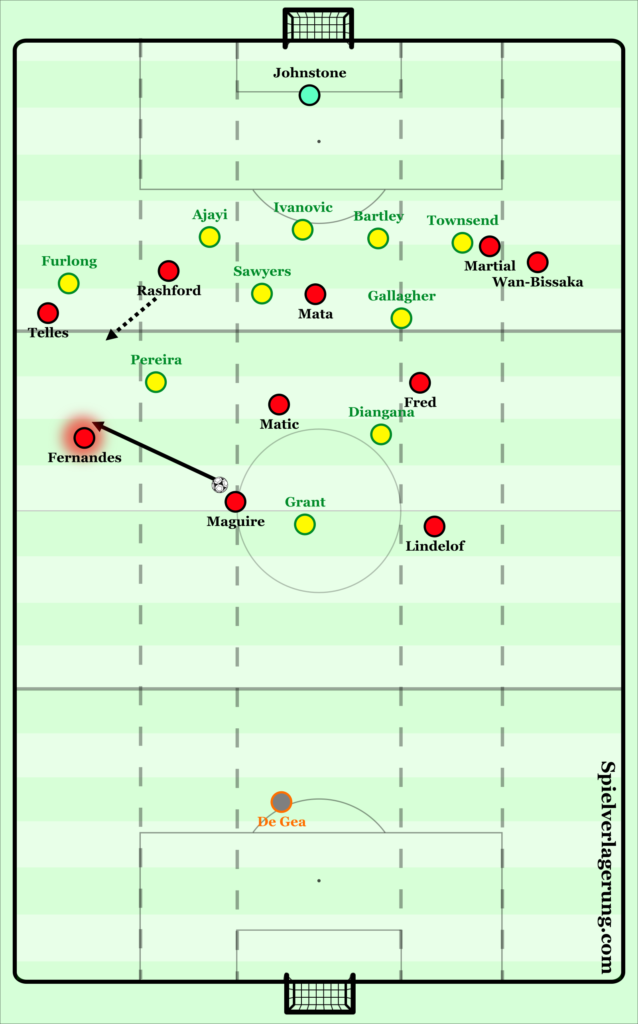
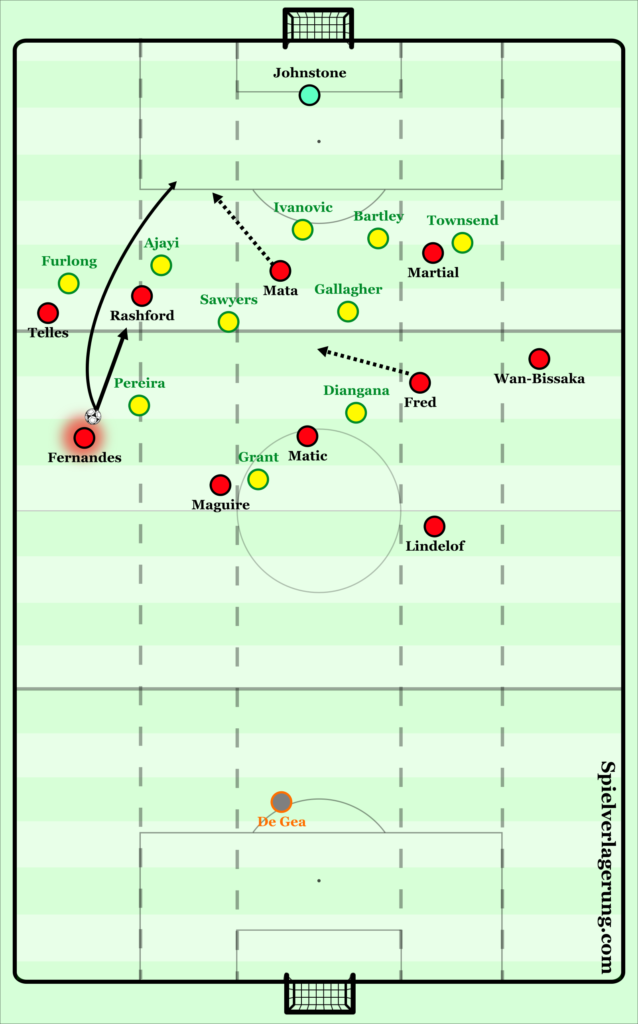
A further aspect in this micro-analysis of Fernandes’ movement and freedom also demonstrates itself as a suitable strategy against defensive approaches such as the one implemented by West Brom. As displayed in the first section, West Brom’s tactical approach neutralised United’s wide 2v1s with the sufficient cover in half-spaces to prevent the overload and force United to rather circulate possession in an attempt to create horizontal gaps between players to penetrate (which occurred less than they may have hoped). It is in these scenarios where Fernandes’ freedom and recognition of such occasions helps United to create and attempt to retain their advantageous overload in wide areas.
The benefit of this is only extended against less defensive opposition, as there is more space between defensive and midfield units, as well as increased distances between individual players to exploit, though it is pertinent to display the advantages against the most compact of opponents. As portrayed below, with West Brom limiting United’s effectiveness in wide areas, Fernandes attempts to pick up intelligent positions outside the central suffocation of West Brom’s midfield box. This allows him to create momentary 3v2s with United’s full-back and winger, which provoke the imminent opportunity to penetrate beyond the opposition’s last line in wider areas.
The below graphics present this, with Fernandes receiving on the left creating a 3v2 against Ajayi and Furlong (outside of the midfield box & more specifically in a position where Pereira is drawn out which stretches the distances between the midfield box horizontally). The first benefit is that rather than simply being occupied by Telles/Rashford, Ajayi and Furlong have now to contend with the imminent threat of Fernandes driving towards them. Therefore, with Furlong as the nearest man he presses cautiously to prevent both a direct pass into Telles (by front-screening him in his pressing run) but also to prevent Fernandes’ progress, this in turn (due to the 3v2) allows Fernandes to combine with a narrower Rashford in the half-space, who is also pinning Ajayi to restrict his interception as well as creating the necessary distance from Telles to allow for a 3rd man combination, and play in-behind the advancing Furlong to the 3rd man run of Telles who can subsequently cross/cut-back into advancing runs into the area.
However, the strategy has an alternative benefit, as if Furlong refuses to engage (maintaining the lockout and defensive security) it still draws Pereira out as previously alluded to and presents the opportunity for Matic/Fred to receive in a more advanced position with the potential to drive forwards or attempt a penetrative forwards pass. Although, as implied previously it may be more beneficial to have a deeper creative player to utilise these vacated spaces in situations when alternate strategies are required against deep lying opposition.
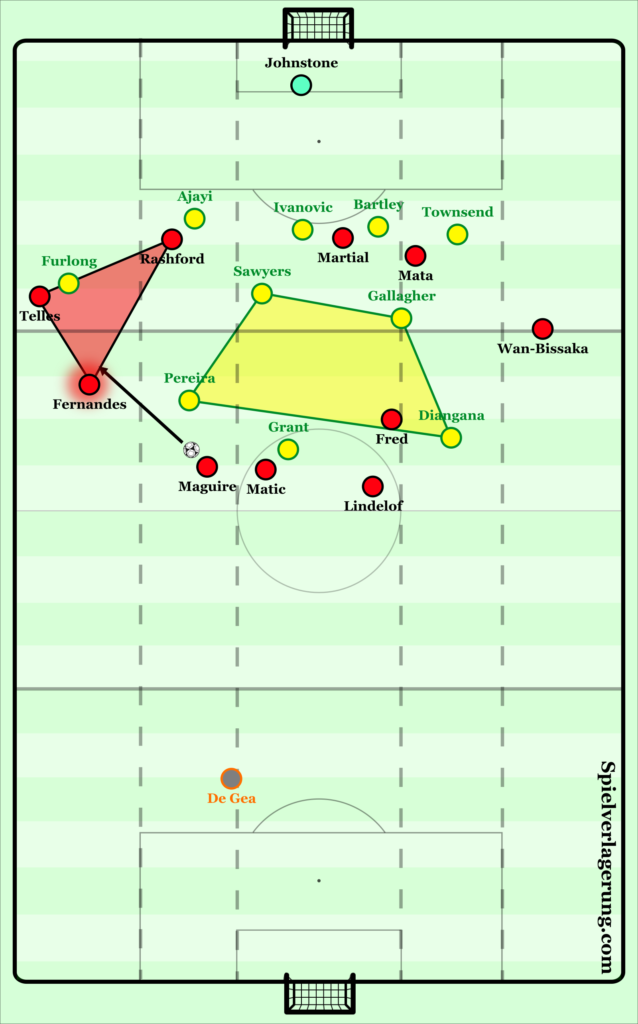
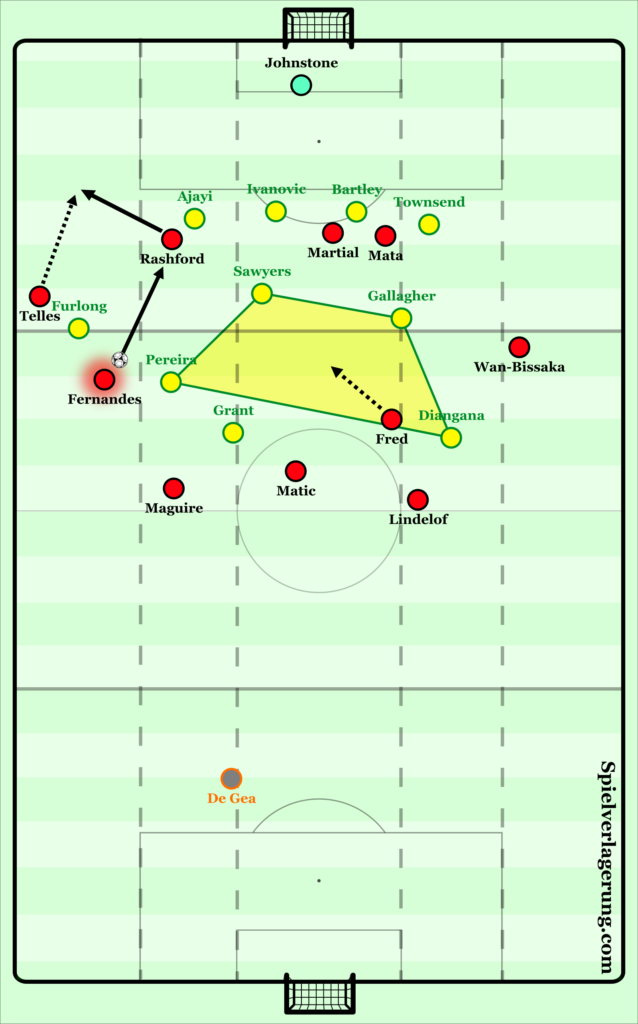
The final element of this section will turn focus onto not how Fernandes positions himself to be the creative component of United’s play as seen in this section so far, but rather how he uses forward runs as an opportunity to penetrate the opposition’s last line when possession is in deeper areas of the pitch (and thus there is exploitable space behind the opposition due to a higher defensive line). This is especially relevant when playing with Martial as the lone striker, who favours dropping in to receive to feet as opposed to runs in the opposite direction (whether this be personal preference or part of a wider tactical approach), perhaps linking to the lack of deeper creativity with less certainty of receiving in behind due to this perceived lack of quality. Regardless of this, this creates and completes the multi-faceted role that Fernandes possesses, with the ability and more importantly the freedom to assert himself on the game in every situation/direction of play.
The below example shows these forward penetrative runs in practice, in the away tie against Istanbul Basaksehir. With possession in a deeper secure area Fernandes makes a curved run, from his natural position beyond the opposition on a diagonal passing line, to receive a direct driven pass over the last line from Maguire with the intention of cutting out both Istanbul’s midfield and defensive line. This was subsequently successful and created a goal-scoring opportunity that in truth Fernandes should have done better. The implicit benefit of his natural receiving position is perceivable in these scenarios, with the opposition defenders likely to either be higher or in tighter proximity to Fernandes than if they were against less intelligent opponents as they are anticipating the stepping up they may have to do to pressurise/intercept passes into Fernandes.
This is compounded by the complimentary movements that Martial make as a trigger for Fernandes’ runs, with Martial dropping deeper to receive and as such drawing the defenders behind him out of structure, once again creating exploitable space for Fernandes (in the below example Fernandes does not utilise this space created by Martial staying in a position ahead of the defensive line, but he has done in other scenarios/matches with blind-side diagonal runs beyond the last line). Of course, these passes are much more adventurous and less likely to have a high success rate, though they help to exemplify the crucial role that Fernandes has within all sides of United’s attacking play.
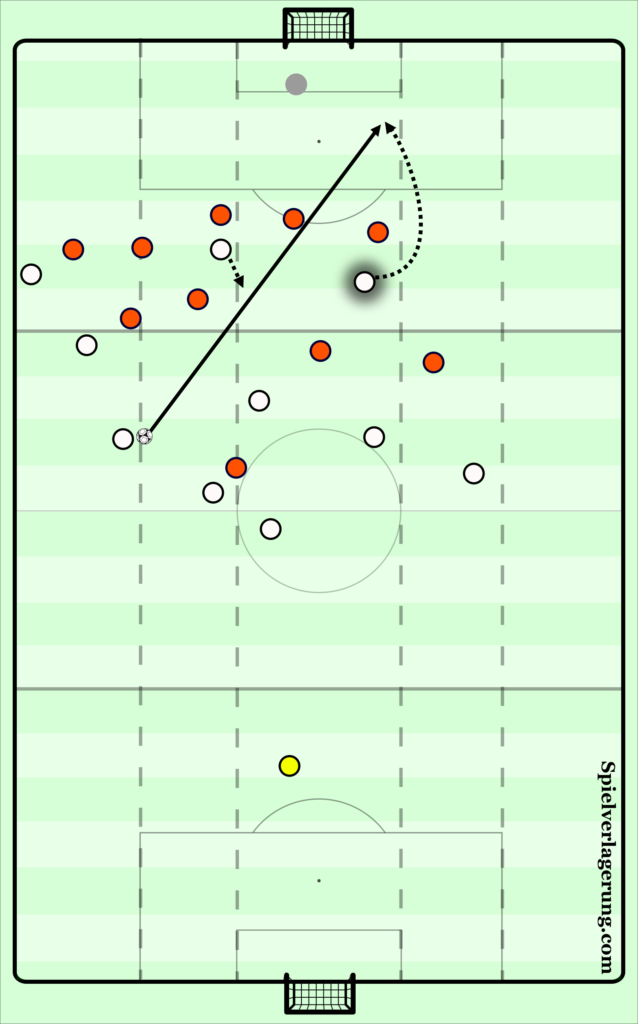
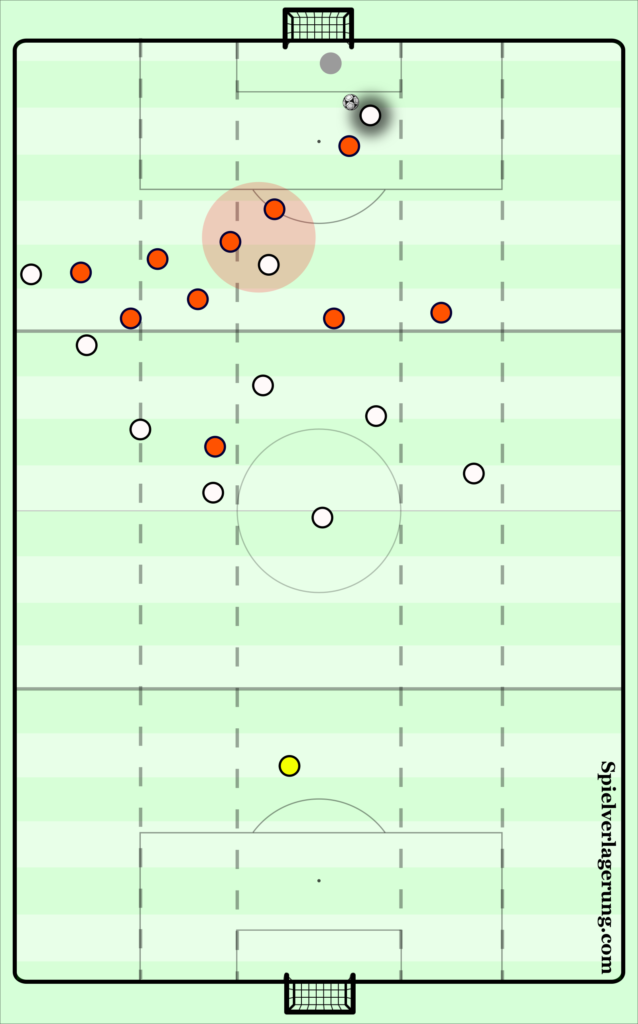
Out of Possession Struggles
Despite their attacking potency, Ole’s team have struggled when out of possession, owing to a lack of effectiveness in stifling the opposition and regaining possession in an effective manner. The first aspect to consider within this section is United’s vulnerability when in defensive transition, particularly when they have a lack of defensive security behind possession. This issue of exposure resides due to the attacking full-back orientated strategy that United possess due to the heightened position of full-backs, with spaces frequently left exploitable in wider areas upon the opposition winning possession and creating quick attacking transitions, leaving United vulnerable to dangerous attacks.
As a trade-off, United must ensure that they have the sufficient players centrally to restore defensive balance or security (on the premise that both full-backs are going to advance). However, United have too often found themselves with only one central-midfielder behind possession (especially earlier in the season), within the 4-2-3-1 this is due to one of the double-pivot advancing ahead of the ball whilst in the 4-1-3-2 this is natural due to its’ systematic nature in the event of wider 8’s advancing ahead of the ball. Consequently, this leaves insufficient players in midfield to delay the opposition (thus allowing full-backs and other midfielders to recover) whilst it also exposes centre-backs to defend in wide areas where there is vacant space to expose (worsened by the fact that Lindelof/Maguire don’t have the athleticism to defend effectively in wider areas). The application of this unbalanced approach within United’s favoured 4-2-3-1 given it is their most used formation can be seen below, something that Tottenham preyed upon in their 6-1 demolition. As shown, Maguire has stepped in with possession against Spurs’ low block and both of United’s full-backs have advanced into positions ahead of the ball, as would be expected within their approach.
This is a viable strategy if off-set with sufficient balance, however United as perceived have no potential to cover opposition forward runs into wide areas, Fernandes has rotated to be a deeper midfielder, whilst Matic is on line with possession (creating a “1-1” central-midfield) and Pogba is the second highest man in play (a positional rotation with Fernandes), furthermore Maguire has stepped in to play meaning there is even more exploitable space in United’s last line. The only player in a suitable position to cover is Bailly, who has been left in a 1v1 with Kane, meaning a forward run that cannot be covered by a recovering players would result in a 2v1 overload in attacking transition. This is exactly the consequence, as Lamela intercepts the pass by Maguire in the first graphic before driving forward and playing the pass over to Son in the second graphic.
Once again referring to United’s positioning, Fernandes fails to delay play in the first instance (one of his only weaknesses is his contribution defensively out of possession), Maguire is unable to recover over the distance in an efficient time whilst Bailly is drawn out by the intelligent decoy run of Kane (this run is essential and if not made would allow Bailly to potentially cover Son instead, however Kane runs directly across Bailly taking his attention and allowing Son to engage in a longer-distance sprint race against Matic). As such, Son can exploit Matic as the second deepest player and utilise his acceleration into the half-space to receive beyond the last line. This issue is replicated even when Maguire in a more natural deeper position, with the “1-1” central midfield failing to protect the central defenders and thus drawing them out into wide areas. Take the scenario below, even if Maguire was deeper Kane/Son would still have a 2v2 against Lindelof/Maguire due to Matic’s inability to recover and protect them as Son is already beyond him (Son would likely have to receive to feet & drive forwards due to Maguire’s aerial ability but the scenario still remains).
This is worsened when considering additional 3rd man runs from deep can push this into a defensive underload should supporting runs be quicker than defensive recovery (e.g. if Sissoko regained possession in the graphics below, Spurs would have had Kane/Lamela/Son potentially against Maguire/Lindelof should Matic not recover in time). This is a clear area for concern with a number of goals conceded in this manner (particularly at home against deep lying opponents), one which United to ensure they rectify by preventing this exposable “1-1” in central-midfield when full-backs are advanced and maintaining enough players in a position to ensure defensive security should they lose possession and face a defensive transition.
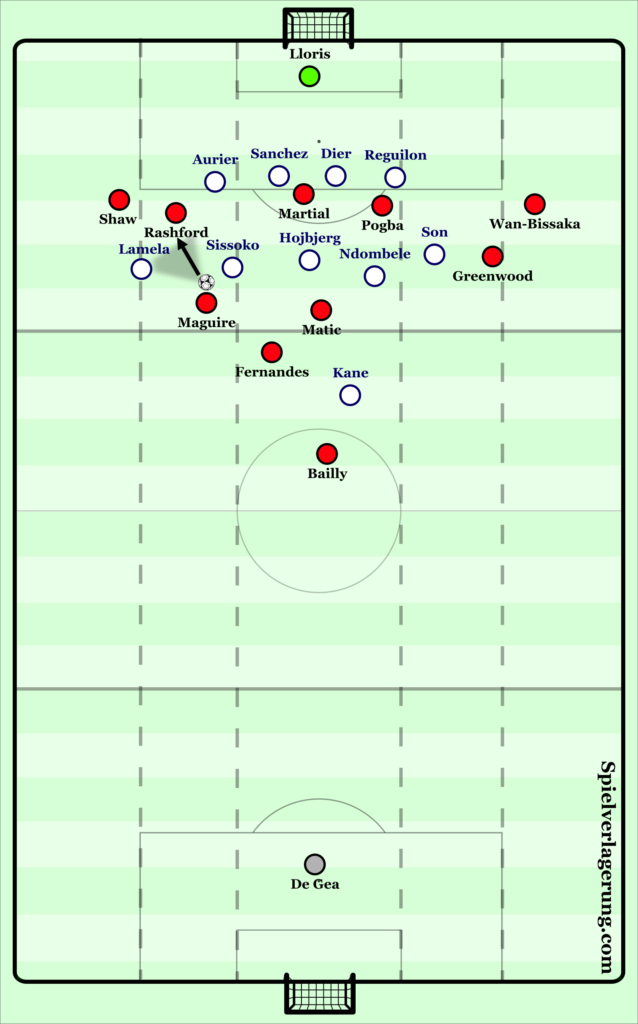
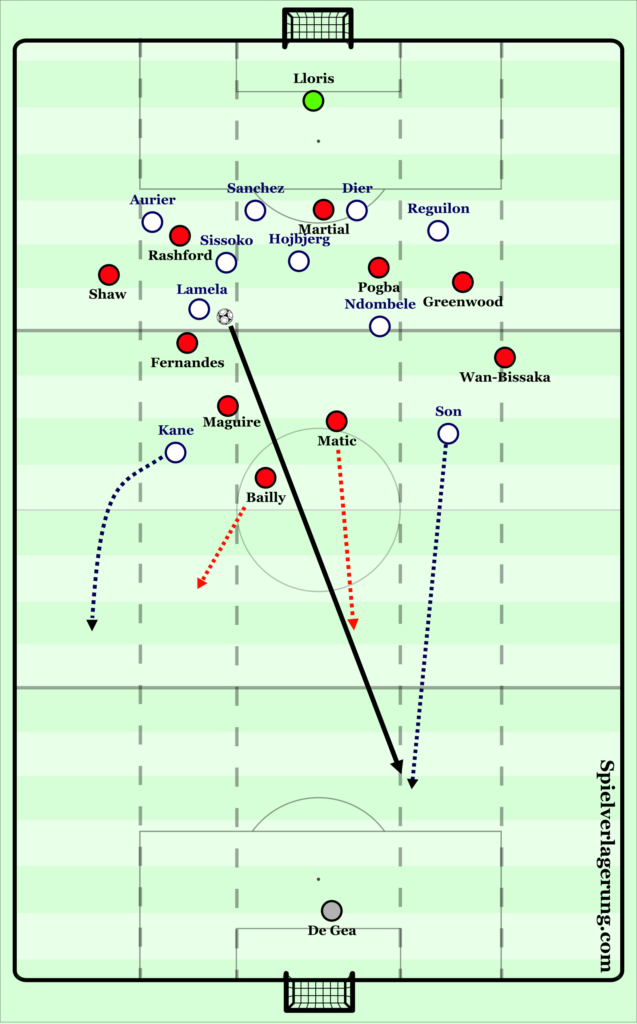
This isn’t the end of United’s struggles from an out of possession perspective, with their pressing approaches often ineffective in regaining possession and preventing the opposition from escaping out of their defensive third. The below example against Arsenal exemplifying this, with Arsenal able to break past United’s front three press easily. Their initial set-up has sound fundamentals, Rashford and Greenwood begin in wider positions with their intent to force play into central areas through curving their pressing runs out-in upon the trigger of passes into Arsenal’s centre-backs (the opposite player, Greenwood tucks in should Rashford press and vice-versa).
Meanwhile, Fernandes is man-man upon Arsenal’s deeper midfield player in order to restrict penetration, though his position in-front of Elneny is of initial concern as if Elneny is able to create the subsequent space behind him United’s press would be broken with one pass (similar to the positioning that we suggested McTominay/Matic/Fred should take up when United are attempting to play out). In deeper areas, United’s remaining midfield line are set-up in a compact line of three, whilst their defensive line is pushed up to the half-way line, restricting the distances that Arsenal’s attacking players have to find space to receive. In deeper areas, there is no clear man-man orientation but rather a structure of cover and ability to travel and press upon the passes into Arsenal’s attacking players, perhaps pre-empting the varying movements & rotations that Arsenal could produce.
The perceived aim is to frustrate Arsenal and prevent their ability to play out through wider areas in which they have overloads higher up the pitch against United’s full-backs and force play centrally from which United can utilise their overload (Fernandes/Pogba/Fred/McTominay v Elneny/Partey) to force them to go longer to which United’s aerial strengths would prevail. However, a simple manipulation breaks United’s press and exposes the lack of secondary or “what if” strategies. As shown in the first graphic, Gabriel is able to play to Elneny who can bounce wider to Tierney due to the lack of immediate pressure from Bruno Fernandes. As a consequence, Fernandes engages upon Tierney as the nearest man with Rashford taking his place centrally, with possession returned to Leno upon this pressure as shown in the second graphic. It is within this scenario that the problems occur, the bringing of Leno into the game creates a 4v3 as shown in the second graphic (excluding Bellerin/Tierney) that allows Arsenal to break directly past Rashford and into the intelligently positioned Elneny beyond the pressing trio.
This raises two considerations, first of all Rashford/Fernandes should have the awareness to prevent passes in-behind them which both have failed to display in this situation, in doing so United would at least retain a level of compactness and restrict the ability for their front line to be penetrated so easily (whether this be a front-screen or simply defending via being goalside on Elneny), whilst if it was done neither the first or second pass would have occurred. Secondly, it presents a lack of consideration for “what if” the press is broken within United’s approach, especially as United have sufficient numbers in deeper areas to attribute another player upon the below eventuality. For example, upon recognition that Elneny could receive beyond the front-line and break the press Pogba could either step higher and restrict this eventuality completely by marking “in contact” or travel upon the trigger of a pass into Elneny as a trigger to intercept (which could even be more lucrative in it’s outcomes if possession was won). This would allow the deeper Fred/McTominay to become a secure central double-pivot whilst United still remain overloaded against Arsenal’s attacking players with their full back four in-tact from a positional perspective.
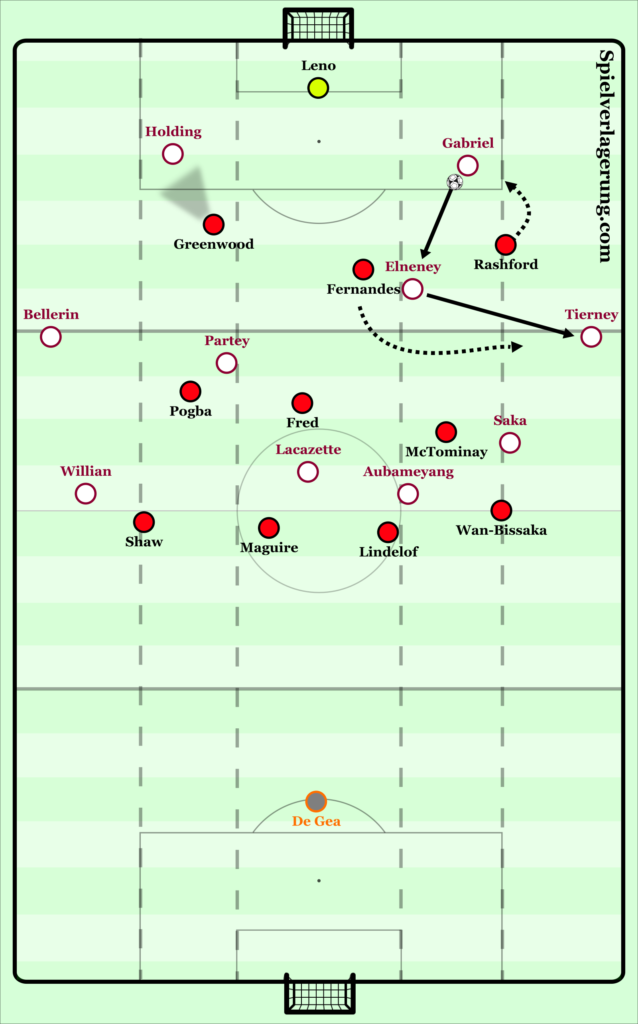
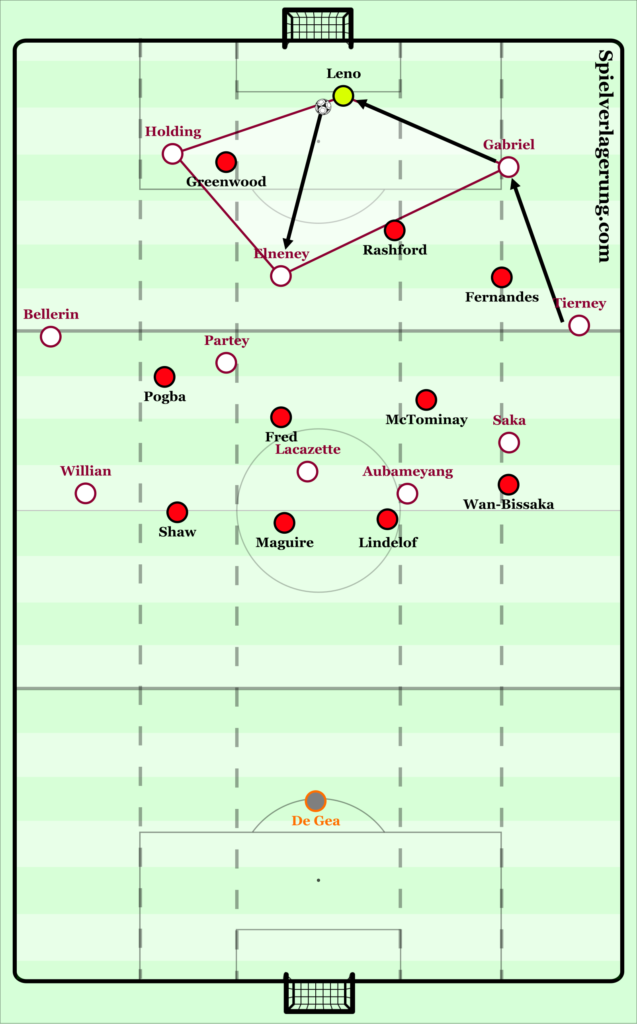
This isn’t an isolated incident, with further inefficiencies displayed in the Europa League via the below example against Istanbul Basaksehir, with a representation of unclear strategic aims leading to being exploited via 2v1 in wide areas. As shown in the left graphic, possession lies with the goalkeeper Gunok with both teams in transition upon play being recycled from the right-hand side. United approach to press with Martial forcing play to one side via a curved pressing run to cut out Skrtel (towards the left side of the pitch), Fernandes is in a position to travel upon the deeper midfield player, whilst Rashford has dropped deeper to prevent play into Rafael.
However, on the opposite side Mata’s inability to recognise priorities of cover leads to United being broken as he maintains a half way position between Epureanu and Bolingoli, which subsequently allows Gunok to clip a driven pass over him into Bolingoli who moves higher up to avoid pressure as the ball is travelling. Looking deeper within United’s midfield and defensive units, the narrowness of van de Beek and Matic mean they cannot travel across to press upon Bolingoli receiving, whilst the near-side full-back (Wan-Bissaka) cannot press as he is already locked off 1v1 against Turuc. As a result, upon Bolingoli receiving he can combine directly in the second phase with Turuc with a 2v1 created against Wan-Bissaka and subsequently Bolingoli receiving an underlapping run that penetrates United’s last line. This once again displays the lack of intelligence within United’s pressing strategies, with Mata taking up a position that allows the opposition to break beyond the front line instantaneously. In the first instance, regardless of where Mata positions himself, he is exposed to a 2v1 against Epureanu and Bolingoli, therefore he must adapt to deny penetration as a first defensive priority.
As such, to prevent this United would have to drop Mata deeper to occupy Bolingoli whilst either Martial/Fernandes pressed onto a pass into Epureanu (on the premise that Martial continued to cut off Skrtel, whilst if Fernandes pressed it would have to continue to force play to the left with Martial dropping to cover the deeper midfielder or Fernandes front-screening through his pressing run), thus allowing suitable pressure to force a mistake or longer play from which United could regain. Secondly, it presents issues within the vertical distances between United’s midfield and attacking lines. As shown in both pressing examples, the opposition have a vast array of space in behind United’s attacking line before they encounter any form of pressure from deeper units, thus providing them with the opportunity to receive without immediate pressure. Therefore, if United wish to press with effectiveness higher up the pitch they must reduce this distance, by pushing the midfield line higher.
This would solve two problems, first of all it would reduce the distances available to the opposition making it harder to combine and restricting the freedom to play out, whilst it would also provide the opportunity for deeper players (central-midfielders) to reside in a heightened position and open up the potential to travel and press players such as Elneney/Bolingoli upon the first pressing line being broken. The alternative for United is to drop into a deeper medium block and simply aim to regain possession in deeper areas through congesting space in compact defensive blocks, though it is clear United need to choose a consistent approach to prevent isolating their front pressing line and ultimately make them harder to break down and penetrate in all areas.
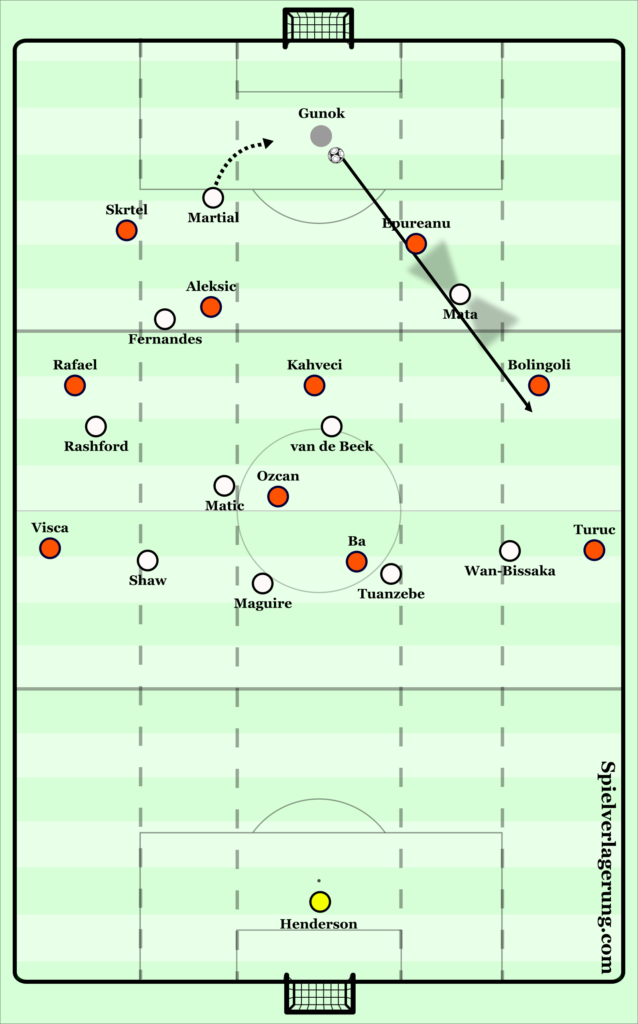
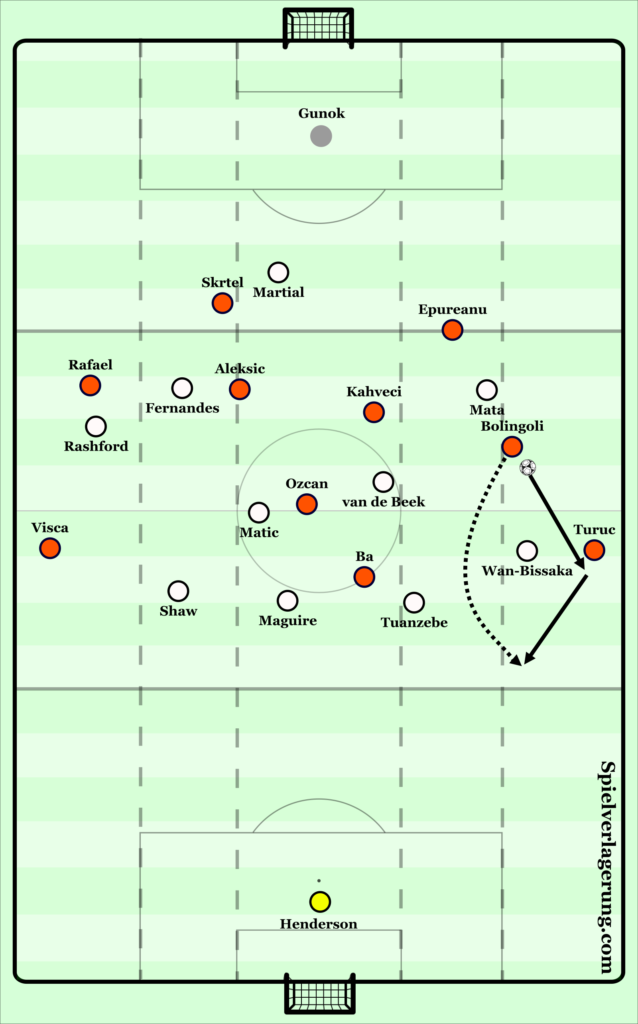
Conclusion
It is evident that Manchester United have had a mixed beginning to the season, but there are certainly positive signs in their performances. From an attacking perspective, they look dangerous and the addition of Cavani may help them to penetrate in alternate ways against teams playing in a low block from which they have notoriously struggled. However, their approach out of possession needs to be more consistent, a focus on retaining balance out of possession and ensuring they are difficult to break down is essential, whether this be through pressing high or dropping into a medium block as conceding almost 2 goals a game on average is unacceptable. Whether Ole can force the Red Devils up the table is still unclear, but ensuring they can find the correct approaches their performances in Europe certainly demonstrate that they have the quality to do so.
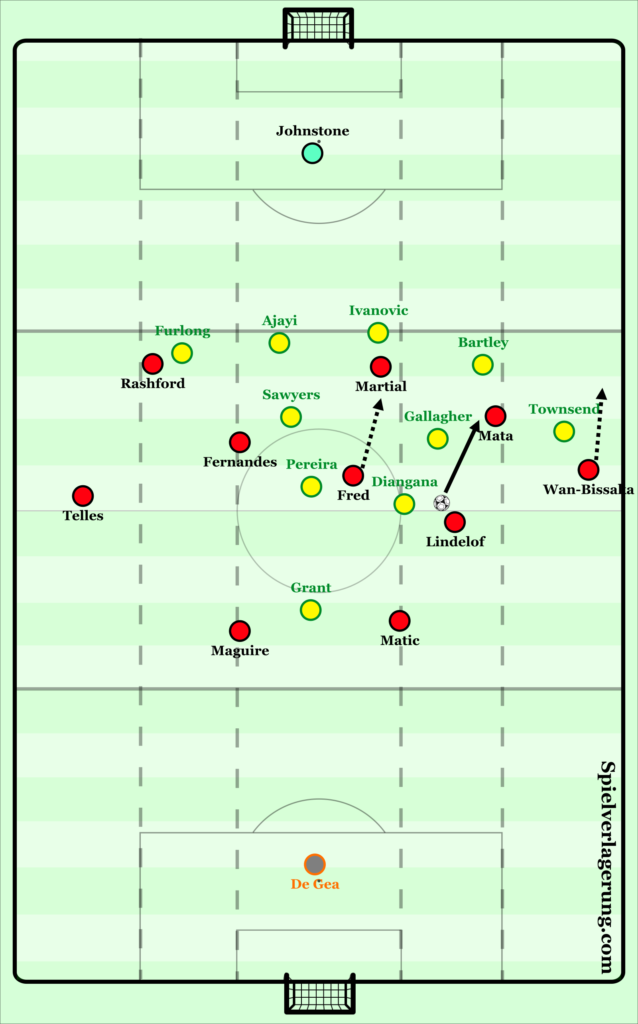
Keine Kommentare vorhanden Alle anzeigen